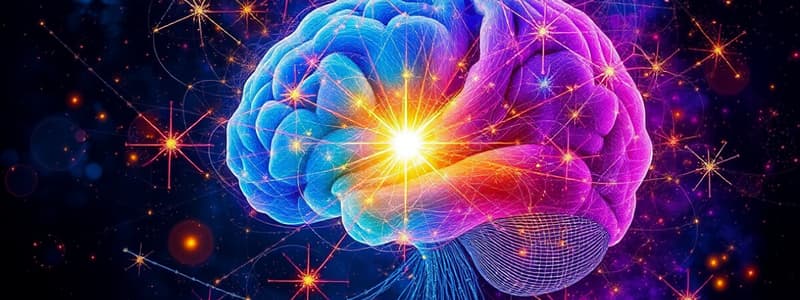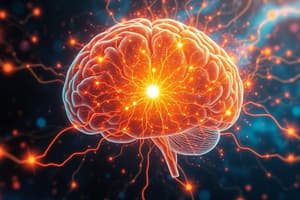Podcast
Questions and Answers
What does the term 'dominant hemisphere' refer to?
What does the term 'dominant hemisphere' refer to?
- The hemisphere that is always larger in size
- The hemisphere that contains language functions (correct)
- The hemisphere that is responsible for emotional regulation
- The hemisphere primarily responsible for visual processing
Which statement best describes cerebral asymmetry?
Which statement best describes cerebral asymmetry?
- Females and males have no significant differences in anatomical asymmetry.
- Cerebral asymmetry is absolute and does not vary among individuals.
- Both hemispheres have completely different functions with no overlap.
- Handedness can affect the representation of language in the hemispheres. (correct)
How do neural plasticity changes manifest?
How do neural plasticity changes manifest?
- Both structural and chemical changes in the brain due to experiences. (correct)
- Only in the organizational aspects of brain structures and not in circuitry.
- Only through the strengthening of existing neural pathways.
- Only through the chemical modification of neurotransmitters.
Which of the following is a true statement regarding sex differences in cerebral asymmetry?
Which of the following is a true statement regarding sex differences in cerebral asymmetry?
What is a key feature of laterality in brain functioning?
What is a key feature of laterality in brain functioning?
What functions fall under the category of 'Higher-Order' functions?
What functions fall under the category of 'Higher-Order' functions?
What type of agnosia involves difficulty in recognizing objects despite having intact vision?
What type of agnosia involves difficulty in recognizing objects despite having intact vision?
Which hemisphere of the brain is primarily involved in spatial behaviour?
Which hemisphere of the brain is primarily involved in spatial behaviour?
What does the term 'topographic memory' refer to?
What does the term 'topographic memory' refer to?
Which of the following best describes 'selective attention'?
Which of the following best describes 'selective attention'?
In the context of attention, which brain regions are primarily involved?
In the context of attention, which brain regions are primarily involved?
What can result from damage to the right hemisphere concerning spatial behaviour?
What can result from damage to the right hemisphere concerning spatial behaviour?
What types of agnosias might affect a single sensory system?
What types of agnosias might affect a single sensory system?
What is the main characteristic of sensory neglect?
What is the main characteristic of sensory neglect?
Which type of apraxia involves difficulties with a sequence of movements due to ideational components?
Which type of apraxia involves difficulties with a sequence of movements due to ideational components?
How does hemianopia differ from sensory neglect?
How does hemianopia differ from sensory neglect?
Which hemisphere is typically associated with language production and comprehension?
Which hemisphere is typically associated with language production and comprehension?
What often accompanies apraxia of speech?
What often accompanies apraxia of speech?
What type of lesion commonly results in ideational apraxia?
What type of lesion commonly results in ideational apraxia?
What is anosognosia often associated with?
What is anosognosia often associated with?
Which function is primarily controlled by the right hemisphere?
Which function is primarily controlled by the right hemisphere?
Flashcards
Agnosia
Agnosia
Inability to recognize sensory stimuli, typically affecting one sensory system, like vision or hearing.
Visual Associative Agnosia
Visual Associative Agnosia
Difficulty recognizing objects visually, despite being able to see their features (like shape, color).
Spatial Behaviour
Spatial Behaviour
Actions and abilities we use to navigate and understand space; includes movement and cognitive maps.
Perception
Perception
Signup and view all the flashcards
Attention
Attention
Signup and view all the flashcards
Executive Functions
Executive Functions
Signup and view all the flashcards
Memory
Memory
Signup and view all the flashcards
Language
Language
Signup and view all the flashcards
Brain Hemisphere Laterality
Brain Hemisphere Laterality
Signup and view all the flashcards
Language Dominance
Language Dominance
Signup and view all the flashcards
Neural Plasticity
Neural Plasticity
Signup and view all the flashcards
Individual Variability (Brain)
Individual Variability (Brain)
Signup and view all the flashcards
Handedness and Brain Language
Handedness and Brain Language
Signup and view all the flashcards
Sensory Neglect
Sensory Neglect
Signup and view all the flashcards
Hemianopia
Hemianopia
Signup and view all the flashcards
Apraxia
Apraxia
Signup and view all the flashcards
Ideational Apraxia
Ideational Apraxia
Signup and view all the flashcards
Apraxia of Speech
Apraxia of Speech
Signup and view all the flashcards
Left Hemisphere (LH) Dominance
Left Hemisphere (LH) Dominance
Signup and view all the flashcards
Right Hemisphere (RH) Function
Right Hemisphere (RH) Function
Signup and view all the flashcards
Cerebral Hemispheric Asymmetry
Cerebral Hemispheric Asymmetry
Signup and view all the flashcards
Study Notes
Higher Cortical Functions & Cognitive/Behavioral Manifestations of Brain Disorders
- Higher-order functions include language, memory, executive functions, perception, spatial behavior, attention, and skilled movement.
- Perception involves cognition resulting from sensory regions beyond the primary sensory cortex. Sensory regions organize into primary, secondary, and tertiary areas.
- Secondary areas interpret sensory input and organize movements.
- Tertiary areas modulate between secondary areas.
Agnosias
- Agnosias are partial or complete inabilities to recognize sensory stimuli.
- These typically affect a single sensory system (vision, audition, tactile).
- Agnosias aren't explained by defects in primary sensory processes or reduced alertness.
- Examples include: visual associative agnosia, this difficulty recognizing objects despite intact vision. Patients can describe features but not recognize objects, may affect a specific class of items like faces, commonly results from occipital and or posterior temporal damage, often bilateral.
- Rubens and Benson (1971) studies showed patients struggle to recognize objects despite copying them.
Spatial Behavior
- Spatial behavior includes all actions guiding bodies through space. Example includes the ability to move from one place to another from memory. The ability to move is linked to topographic memory.
- Mental representations of space are called cognitive maps.
- Spatial behaviors and abilities are highly linked to the right hemisphere of the brain. Disruptions in spatial abilities often related to right hemisphere (RH) damage.
- Disruptions include egocentric disorientation, heading disorientation, landmark agnosia, anterograde disorientation, spatial-mapping or memory deficit. These impairments are linked to specific brain damage locations within the right hemisphere.
Attention
- Attention involves processes that either selectively focus on aspects of the sensory environment, or respond selectively to one class of stimuli.
- Attention can be different types (e.g., selective, divided), and it can be sensory modality specific.
- Attention is related to executive functions.
- Attention deficits are often bilateral across multiple brain regions, like the brain stem, sensory regions, parietal, cingulate and the prefrontal cortex.
- Damage from neurologic disorders, such as TBI, commonly results in deficits.
- Severity of deficits on one side of the body is often called sensory neglect or hemi-inattention.
Sensory Neglect
- Sensory neglect is characterized by the inability to respond, report, or attend to stimuli on the side opposite the brain lesion, even despite adequate sensory and motor functions.
- It can occur across different modalities, such as visual, auditory, and somatosensory.
- Often accompanying anosoagnosia, it typically results from right parietal damage, leading to left-sided neglect.
Skilled Movement
- Skilled movement involves complex sequences of motor actions.
- Prefrontal cortex plans these actions while the premotor cortex organizes and sequences them.
- Posterior cortex sends goals, and sensory information. The motor cortex executes these actions.
Apraxia
- Apraxia is a disorder in skilled movement, not related to muscle weakness or other primary motor disturbances.
- It affects the "high-level" motor functions, such as planning, sequencing of actions. Examples may include difficulties with goal-directed movements or using familiar objects in a meaningful way.
- Examples include Ideational apraxia, where difficulty coordinating movement involves some problem with planning; or Apraxia of speech, coordinated motor sequences involving sounds.
Cerebral Asymmetry
- Traditional ideas suggest left hemisphere (LH) dominance for language production and comprehension, and controlling movement in the right side of the body.
- Right hemisphere (RH) is associated with perceiving and synthesizing spatial/nonverbal information, and movement control of the left side of the body.
- Evidence from neurological patients with lateralized lesions shows common deficits like language, verbal memory, and other language production and comprehension, visual/spatial abilities etc. on one hemisphere versus the other.
- Laterality is relative and not absolute. Both hemispheres participate in most behaviors.
- The site of damage matters as well as the location, as related areas of the brain can be more or less similar versus areas that are vastly different in function.
- Individual variations, such as handedness and sex differences, also influence cerebral asymmetry.
- Handedness and sex variations influence the location of neurological function and involvement of the brain.
Neural Plasticity
- Neural plasticity describes the brain's ability to change in response to experience.
- These changes are structural (e.g., size, organization of brain areas and circuits) and chemical (e.g., neurotransmitter distribution and amount).
- Neural networks are strengthened or weakened in these changes. These changes happen most easily in young developing brains, but occur throughout life.
Studying That Suits You
Use AI to generate personalized quizzes and flashcards to suit your learning preferences.
Related Documents
Description
This quiz explores higher-order cognitive functions and the manifestations of brain disorders such as agnosias. Understand the intricate relationships between sensory perceptions and cognitive behavior. Test your knowledge on the classification and implications of these cognitive impairments.



